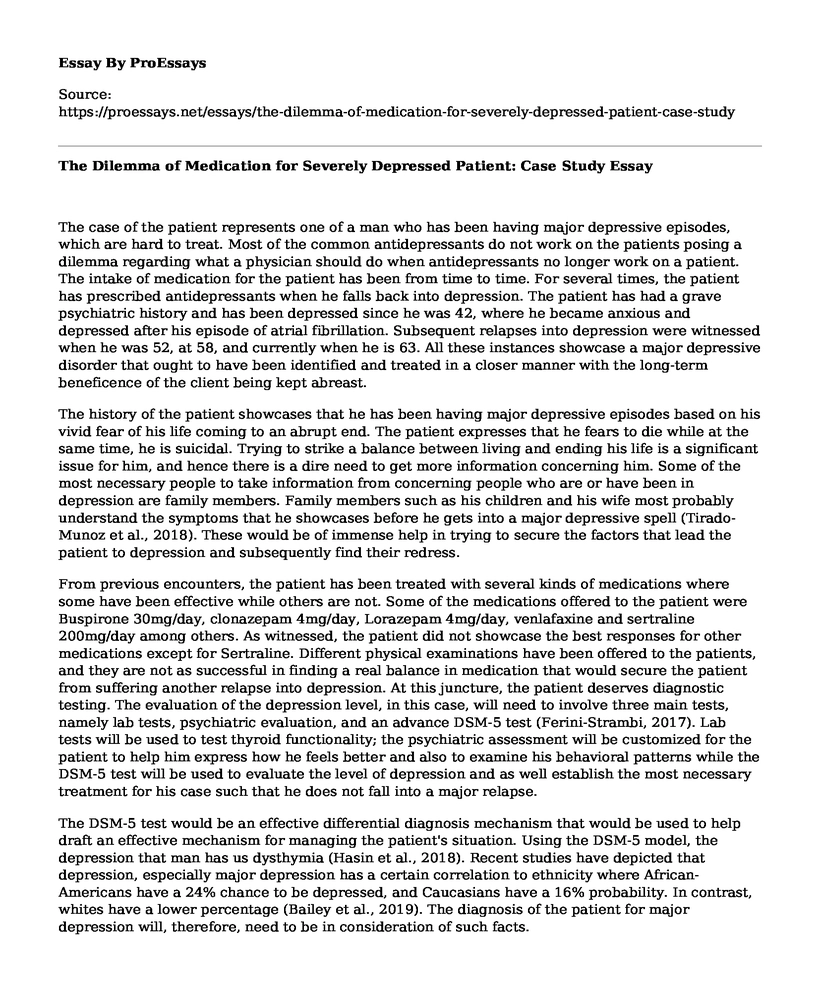The case of the patient represents one of a man who has been having major depressive episodes, which are hard to treat. Most of the common antidepressants do not work on the patients posing a dilemma regarding what a physician should do when antidepressants no longer work on a patient. The intake of medication for the patient has been from time to time. For several times, the patient has prescribed antidepressants when he falls back into depression. The patient has had a grave psychiatric history and has been depressed since he was 42, where he became anxious and depressed after his episode of atrial fibrillation. Subsequent relapses into depression were witnessed when he was 52, at 58, and currently when he is 63. All these instances showcase a major depressive disorder that ought to have been identified and treated in a closer manner with the long-term beneficence of the client being kept abreast.
The history of the patient showcases that he has been having major depressive episodes based on his vivid fear of his life coming to an abrupt end. The patient expresses that he fears to die while at the same time, he is suicidal. Trying to strike a balance between living and ending his life is a significant issue for him, and hence there is a dire need to get more information concerning him. Some of the most necessary people to take information from concerning people who are or have been in depression are family members. Family members such as his children and his wife most probably understand the symptoms that he showcases before he gets into a major depressive spell (Tirado-Munoz et al., 2018). These would be of immense help in trying to secure the factors that lead the patient to depression and subsequently find their redress.
From previous encounters, the patient has been treated with several kinds of medications where some have been effective while others are not. Some of the medications offered to the patient were Buspirone 30mg/day, clonazepam 4mg/day, Lorazepam 4mg/day, venlafaxine and sertraline 200mg/day among others. As witnessed, the patient did not showcase the best responses for other medications except for Sertraline. Different physical examinations have been offered to the patients, and they are not as successful in finding a real balance in medication that would secure the patient from suffering another relapse into depression. At this juncture, the patient deserves diagnostic testing. The evaluation of the depression level, in this case, will need to involve three main tests, namely lab tests, psychiatric evaluation, and an advance DSM-5 test (Ferini-Strambi, 2017). Lab tests will be used to test thyroid functionality; the psychiatric assessment will be customized for the patient to help him express how he feels better and also to examine his behavioral patterns while the DSM-5 test will be used to evaluate the level of depression and as well establish the most necessary treatment for his case such that he does not fall into a major relapse.
The DSM-5 test would be an effective differential diagnosis mechanism that would be used to help draft an effective mechanism for managing the patient's situation. Using the DSM-5 model, the depression that man has us dysthymia (Hasin et al., 2018). Recent studies have depicted that depression, especially major depression has a certain correlation to ethnicity where African-Americans have a 24% chance to be depressed, and Caucasians have a 16% probability. In contrast, whites have a lower percentage (Bailey et al., 2019). The diagnosis of the patient for major depression will, therefore, need to be in consideration of such facts.
The differential diagnosis for the patient seeing the way that he has lapsed into depression for long will involve three main factors. One of the identifiers will be extreme fears and anxiety during the morning. The other one will be a vivid showcasing of suicidal thoughts and, lastly, fears about mortality. Considering this differential diagnosis, it will be necessary to conclude that the medication which has been seen to work with him, which is sertraline 200 mg/day, be used until the patient recovers and treatment with the same be continued once the patient showcases similar symptoms in the future.
References
Bailey, R. K., Mokonogho, J., & Kumar, A. (2019, February 22). Racial and ethnic differences in depression: current perspectives. Neuropsychiatric disease and treatment, 15, 603. Doi: 10.2147/NDT.S128584
Ferini-Strambi, L. (2017). RLS/WED: Criteria, Differential Diagnosis and Prevalence of Occurrence. In Restless Legs Syndrome/Willis Ekbom Disease (pp. 1-18). Springer, New York, NY. https://link.springer.com/chapter/10.1007/978-1-4939-6777-3_1
Hasin, D. S., Sarvet, A. L., Meyers, J. L., Saha, T. D., Ruan, W. J., Stohl, M., & Grant, B. F. (2018, April). Epidemiology of adult DSM-5 major depressive disorder and its specifiers in the United States. JAMA psychiatry, 75(4), 336-346. doi:10.1001/jamapsychiatry.2017.4602
Tirado-Munoz, J., Farre, A., Mestre-Pinto, J., Szerman, N., & Torrens, M. (2018). Dual diagnosis in depression: treatment recommendations. Adicciones, 30(1). http://www.biblioteca.cij.gob.mx/Archivos/Materiales_de_consulta/Drogas_de_Abuso/Articulos/PatologiaDualDepression_.PDF
Cite this page
The Dilemma of Medication for Severely Depressed Patient: Case Study. (2023, Apr 23). Retrieved from https://proessays.net/essays/the-dilemma-of-medication-for-severely-depressed-patient-case-study
If you are the original author of this essay and no longer wish to have it published on the ProEssays website, please click below to request its removal:
- Work-ready Skills: A Personal Action Plan Example
- Soft Power Influence Essay
- How Social Media Affects One's Self-Esteem Essay
- The Barbie Doll and Female Beauty Standards - Essay Sample
- Essay Sample on Christian Reformers as Heroes
- Essay on Counselors Helping Battered Women to Overcome Career Challenges
- Essay on SEL Standards: Turning Teachers Into Therapists and Students Into Patients?







